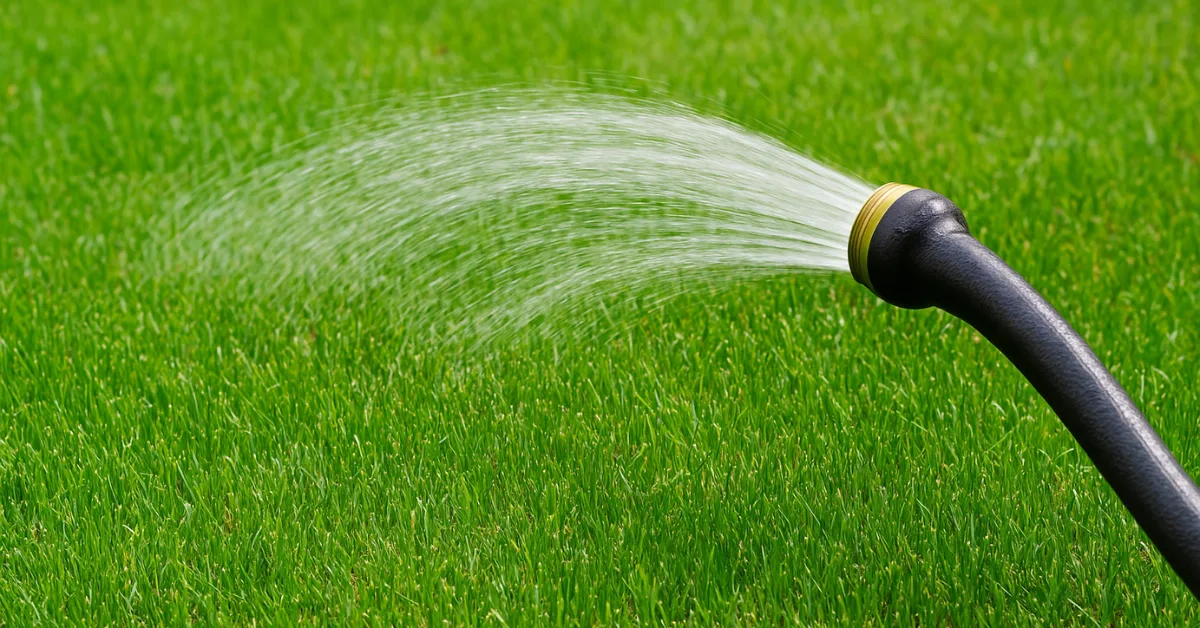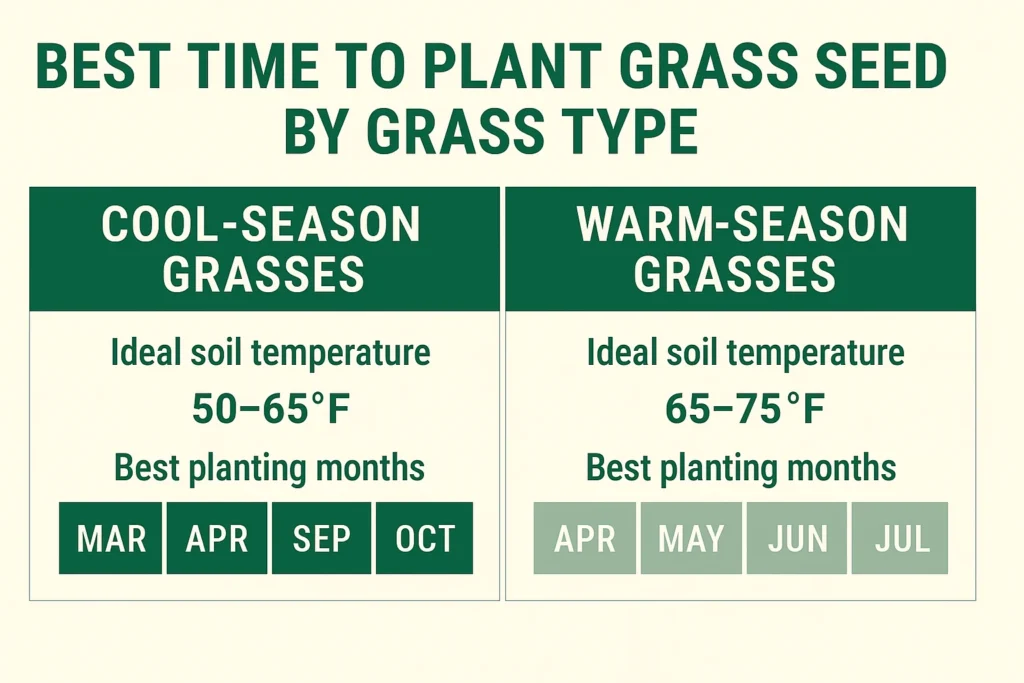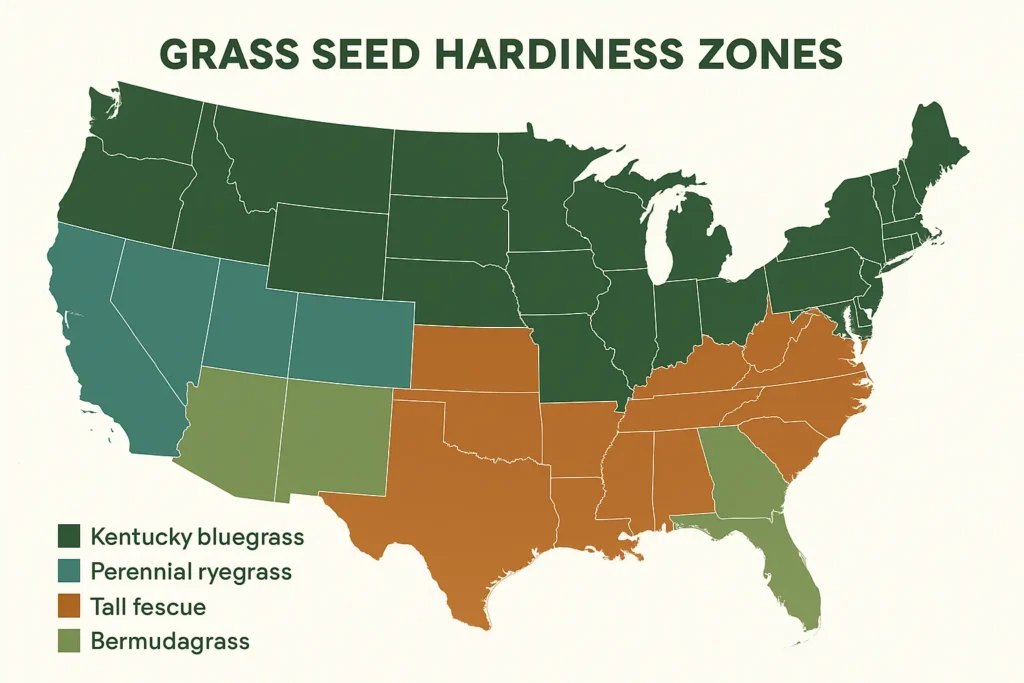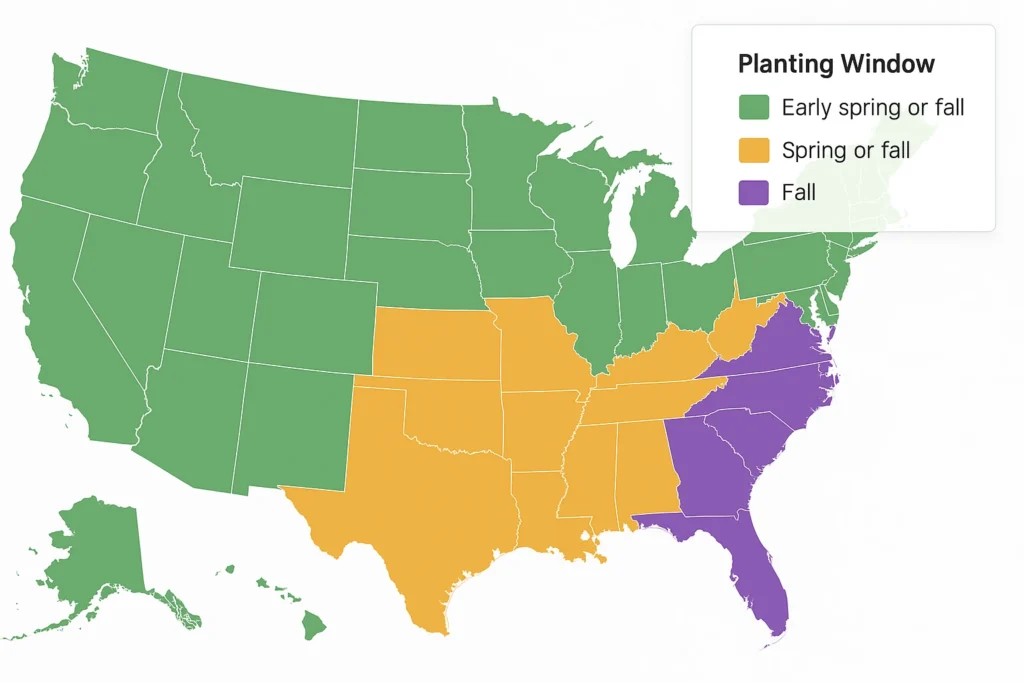The Best Time to Plant Grass Seed (By Season, Region & Grass Type)

A thick, green lawn doesn’t start with fertilizer or frequent mowing — it starts with knowing the best time to plant grass seed. Whether you’re starting fresh or fixing bare patches, timing is everything. Too early, and seeds may rot. Too late, and they won’t take root before temperature changes or drought set in.
The best time to plant grass seed depends on where you live, the type of grass you’re planting, and the season you’re working with. Cool-season grasses like Kentucky bluegrass and tall fescue thrive in early fall, while warm-season varieties such as Bermuda and zoysia grow best in late spring to early summer.
This guide breaks down the ideal planting times, temperature for grass seed germination, and even how long it takes grass seed to grow once it’s in the soil. We’ve also included regional planting tips, FAQs like “How late can you plant grass seed?”, and a few useful tools and calculators to plan your lawn project right.
Table of Contents
Best Time to Plant Grass Seed: Quick Answer
The best time to plant grass seed is early fall for cool-season grasses and late spring for warm-season varieties. In most regions, mid-August through mid-October offers the perfect mix of soil warmth and mild air temperatures that support strong root development without the stress of summer heat.
Cool-season grasses such as Kentucky bluegrass, perennial ryegrass, and tall fescue prefer soil temperatures between 50°F and 65°F for optimal germination. For warm-season grasses like Bermuda and zoysia, wait until soil temps reach 65°F to 70°F and all danger of frost has passed.
If you’re planting a new lawn or overseeding, these windows give your grass seed the best chance to sprout, establish, and outcompete weeds. Use our Grass Seed Calculator to etermine the exact amount of grass seed needed for planting or overseeding.
Grass Seed Timing Tool
Why Timing Matters for Grass Seeding?
Getting the best time to plant grass seed right isn’t just about convenience — it’s about giving your lawn the strongest start possible. Grass seed is finicky. It needs the right combination of soil temperature, moisture, and light to germinate properly and establish deep roots.
Each type of grass has a preferred germination range. Most cool-season varieties need soil temperatures between 50°F and 65°F, while warm-season grasses want 65°F to 70°F or higher. Plant too early and the seed may sit dormant or rot. Plant too late and it may sprout, only to be killed by heat, drought, or frost.
Timing also affects competition. Early fall seeding, for example, means fewer weeds and more stable moisture levels. On the other hand, sowing grass in summer often leads to weak root systems that struggle in high heat, even with consistent watering.
In short, understanding temperature for grass seed germination and seasonal climate patterns is the first step toward a healthy, resilient lawn. Timing sets the foundation — everything else builds on it.
Best Time to Plant Grass Seed by Grass Type
Not all grass is created equal — and neither is the best time to plant grass seed. Each type has its own seasonal preferences based on its growing cycle and climate tolerance.
1. Cool-Season Grasses
Cool-season grasses include Kentucky bluegrass, perennial ryegrass, and tall fescue. These are ideal for northern and transition zone lawns where summers are moderate and winters are cold.
- Kentucky bluegrass is known for its dense, carpet-like appearance but germinates slowly — often taking 14 to 30 days. It thrives when planted in late summer to early fall, when soil temps are around 55°F to 65°F.
- Perennial ryegrass germinates fast — in just 5 to 10 days — and is great for quick cover, overseeding, or erosion-prone areas.
- Tall fescue handles heat and drought better than most cool-season grasses, making it a strong choice for high-traffic lawns.
📍 Best time to plant lawn with cool-season grasses: Mid-August to mid-October. Spring planting is also possible, but expect more weed pressure and slower root development.
2. Warm-Season Grasses
Warm-season grasses such as Bermudagrass, zoysiagrass, centipedegrass, and St. Augustine are well-suited to southern climates with hot summers and mild winters.
- Bermudagrass spreads aggressively and loves full sun, but it needs warm soil — at least 65°F — to germinate properly.
- Zoysiagrass is slower to establish but forms a thick, carpet-like turf with excellent drought resistance.
- Centipedegrass and St. Augustine are low-maintenance options that do well in acidic soils and humid regions.
📍 Best time to plant lawn with warm-season grasses: Late spring to early summer, after the last frost, when soil temps are consistently above 65°F.
Understanding the type of grass you’re planting helps you time things right — and knowing how long for grass seed to grow will help you plan care and watering accordingly.
Grass Seed and Hardiness Zones
Understanding USDA hardiness zones helps fine-tune the best time to plant grass seed — especially if you’re on the edge between cool- and warm-season turf regions.
The USDA hardiness zone map divides the U.S. into regions based on average annual minimum winter temperatures. While this guide is usually used for trees and perennials, it’s also a useful reference for selecting grass seed that thrives in your climate.
🌾 Cool-Season Grass Zones (Zones 3–6)
These zones include the Upper Midwest, Northeast, and parts of the Pacific Northwest. Winters are cold, and summers are mild. Cool-season grasses like:
- Kentucky bluegrass
- Tall fescue
- Perennial ryegrass
…perform best here when seeded in late summer to early fall, or early spring if you miss the fall window.
🌿 Transition Zones (Zones 6–8)
This band stretches across parts of Tennessee, North Carolina, Oklahoma, and northern Georgia. You can grow both cool- and warm-season grasses, but success depends on microclimates and soil temps. Choosing a blend or planting during transitional months gives you flexibility.
☀️ Warm-Season Grass Zones (Zones 8–11)
Southern states like Florida, Texas, and parts of California fall into this range. Warm-season grasses such as:
- Bermudagrass
- Zoysiagrass
- Centipedegrass
…need higher soil temperatures (65–75°F) to germinate. Your best time to plant grass seed is late spring through early summer, after all danger of frost has passed.
🔍 Not sure what zone you’re in? Use the USDA’s Plant Hardiness Zone Map or check our state-by-state planting guides for grass types tailored to your region.
Best Time to Plant Grass Seed by Season
The best time to plant grass seed can shift depending on the season — and understanding the pros and cons of each can make or break your results. Each season offers a unique balance of temperature, moisture, and sunlight. Here’s what to expect.
1. Spring
Spring can be a good time to seed, especially for cool-season grasses, but it’s not without challenges. Soil temperatures are warming, but weeds are waking up too. You’ll need to stay ahead on watering and watch for crabgrass and other spring invaders.
- Ideal for: Early starters in cooler climates
- Soil temp target: 50°F to 65°F
- Read more: Planting Grass in Spring – Tips by Region
2. Summer
Sowing grass in summer is risky but not impossible — especially for warm-season grasses like Bermuda and zoysia. The biggest challenge is keeping new seedlings moist without overwatering. Shade and mulch can help, and evening watering is often more effective in high heat.
- Ideal for: Warm-season turf in southern states
- Soil temp target: 65°F to 75°F
- Read more: How to Plant Grass Seed in Summer Heat
3. Fall
This is the best time to plant grass seed for cool-season lawns. Soil is still warm, air temperatures are mild, and weeds are on the decline. It gives your lawn a strong head start before winter dormancy.
- Ideal for: Kentucky bluegrass, fescue, ryegrass
- Soil temp target: 55°F to 65°F
- Read more: Fall Grass Seeding Guide for Every Region
4. Winter
Most grasses go dormant in winter, but dormant seeding is a useful trick in colder zones. You spread seed before snowfall or during a freeze — and as the ground thaws in spring, the seed naturally settles and germinates.
- Ideal for: Northern climates with predictable freeze-thaw cycles
- Read more: Dormant Seeding Techniques for Winter Lawns
Still unsure? Check out our Grass Seed Calculator for personalized suggestions.
Best Time to Plant Grass Seed by Region
Regional climate plays a major role in choosing the best time to plant grass seed. A seeding window that works in Michigan may fail in Florida. That’s why we’ve created detailed, state-specific guides to help you make the right call for your lawn — whether you’re in the humid Southeast or the dry West.
Here’s a quick breakdown by location, with links to micro pages for a deeper dive:
- When to Plant Grass Seed in Michigan – Cool-season turf thrives in late summer to early fall
- When to Plant Grass Seed in Pennsylvania – Spring or fall planting depending on your zone
- When to Plant Grass Seed in Colorado – Tackle variable weather and dry conditions with timing tips
- When to Plant Grass Seed in Texas – Learn the best times for Bermuda, Zoysia, and more
- When to Plant Grass Seed in Ohio – Best practices for cool-season grasses in Midwest climates
- When to Plant Grass Seed in Illinois – Avoid windburn and frost with season-specific tips
- When to Plant Grass Seed in Georgia – Focus on warm-season varieties and irrigation timing
- When to Plant Grass Seed in Florida – Seeding around tropical rain patterns and heat
- When to Plant Grass Seed in California – Different zones mean different seeding calendars
- When to Plant Grass Seed in North Carolina – Tips for Piedmont, coastal, and mountain regions
- When to Plant Grass Seed in Tennessee – Regional breakdowns for transitional planting zones
If your state isn’t listed, our interactive Grass Seed Timing Tool can help. Just select your state to find your local best time to plant lawn and grass type recommendations.
Grass Seed Germination Temperature
No matter how good your soil is or how carefully you water, your grass seed won’t sprout unless the ground is warm enough. Soil temperature is one of the most overlooked factors when determining the best time to plant grass seed.
Each type of grass seed has a temperature “sweet spot” for germination. Cool-season grasses like Kentucky bluegrass and tall fescue germinate best between 50°F and 65°F. Warm-season varieties such as Bermuda and zoysia need soil to hit at least 65°F to 70°F before they’ll grow reliably.
Here’s a quick breakdown:
Kentucky Bluegrass
Soil Temp: 55–65°F
Germination: 14–30 days
Tall Fescue
Soil Temp: 50–65°F
Germination: 7–12 days
Perennial Ryegrass
Soil Temp: 50–65°F
Germination: 5–10 days
Bermudagrass
Soil Temp: 65–75°F
Germination: 10–30 days
Zoysiagrass
Soil Temp: 65–70°F
Germination: 14–21 days
You can use a simple soil thermometer to test your lawn’s temperature a few inches below the surface. Planting too early, before reaching the right grass seed germination temperature, often leads to rot, slow sprouting, or total failure.
How Long Does Grass Seed Take to Grow?
Knowing the best time to plant grass seed is step one. But understanding how long for grass seed to grow helps set expectations and avoid the common frustration of waiting too long — or giving up too soon.
Most grass seed takes anywhere from 5 to 30 days to germinate, depending on the species and soil conditions. But germination is just the beginning. True growth and lawn establishment can take 6 to 10 weeks, especially if the weather turns unpredictable.
Here’s a general timeline by grass type:
Temperature matters a lot. If the grass seed germination temperature isn’t right, everything slows down. Cool soil can delay growth, while hot, dry conditions can kill seedlings before they establish.
How Late Can You Plant Grass Seed?
If you’ve missed the optimal window, you’re probably asking: how late can you plant grass seed and still get results? The short answer: it depends on your grass type, location, and soil temperature — but there is a limit.
For cool-season grasses, you can usually seed as late as mid-October in northern states — as long as soil temperatures stay above 50°F. Go any later and your seed may germinate just in time to be killed by frost or winter desiccation.
For warm-season grasses, the cutoff is earlier. Once daytime temps drop below 70°F, soil temperatures fall quickly, and germination slows or stops. In southern zones, this typically means wrapping up seeding by early September.
If you’re truly past the season, consider dormant seeding: scattering grass seed just before winter sets in. It won’t germinate right away, but as temps warm in spring, it will naturally sprout.
To avoid wasted time and seed, use our State Timing Guides to pinpoint your last safe planting date. Or better yet, use our interactive seeding calculator to see if you’re still in the clear for planting the best time to plant grass seed in your area.
When Should I Reseed My Lawn?
Even a healthy lawn gets tired. Over time, grass thins out, bare spots form, and weeds sneak in. That’s where overseeding comes in. If you’re wondering when should I reseed my lawn, timing it around the best time to plant grass seed ensures your efforts actually take root.
For cool-season grasses, early fall is ideal — late August to mid-October in most northern regions. The soil’s still warm, the air is cooler, and there’s less competition from weeds. If fall passes you by, early spring is your second chance, though you’ll need to manage weeds more closely.
For warm-season lawns, reseeding works best in late spring to early summer, once soil temperatures hit 65°F or more. Avoid late-summer overseeding, especially during drought or extreme heat.
Before reseeding, test your soil, mow your lawn short, and clear away thatch. Then, follow up with a quality starter fertilizer and daily light watering for the first 10–14 days.
💡 Need help budgeting? Use our:
- Lawn Mowing Cost Calculator to estimate seasonal maintenance
- Lawn Care Cost Calculator to plan for overseeding, fertilizing, and watering
A fresh round of seed at the right time can make a patchy lawn look brand new — just remember, timing is everything.
Seeding FAQs
Still have questions? You’re not alone. Here are answers to some of the most common concerns about grass seeding, timing, and care — all with the goal of helping you find the best time to plant grass seed for your yard.
Can I plant grass in summer?
You can — but it’s not ideal unless you’re planting warm-season grasses like Bermuda or zoysia. Sowing grass in summer means you’ll battle heat stress and need to water often. Stick to early morning or evening watering and watch soil temps (65°F to 75°F minimum).
Should I fertilize when planting grass seed?
Yes. Use a starter fertilizer high in phosphorus to support root development. Avoid nitrogen-heavy products early on — they’ll feed weeds more than seedlings.
How often should I water new grass seed?
Keep the top 1–2 inches of soil consistently moist. That means light watering 1–2 times a day for the first two weeks. As your grass grows, you can scale back to deeper, less frequent watering.
Is it okay to walk on newly seeded areas?
Avoid it as much as possible. Foot traffic compresses soil, disrupts germination, and weakens tender roots. Wait until your new lawn is mowed at least twice before resuming normal use.
What if it rains right after I plant?
Light rain helps — it soaks in seed and soil. But a heavy downpour can wash seed away, especially on slopes. If that happens, you may need to lightly reseed and use straw or seed blankets for erosion control.
Do I need to rake in grass seed?
Yes. Lightly raking helps seed make contact with the soil, which improves grass seed germination temperature response and root anchoring. Don’t bury it too deep — a ¼ inch is plenty.
Have more questions? Check out our full guides by season and state, or plug in your zip code to our Grass Seed Calculator for personalized help.
Common Mistakes to Avoid
Even if you know the best time to plant grass seed, a few simple missteps can ruin the results. Here are the most common mistakes homeowners make — and how to avoid them.
1. Planting at the wrong time
Timing is everything. Seeding too early or too late means your grass might not germinate, or worse — sprout and die. Use soil temp, not just air temp, to determine the best time to plant lawn.
2. Ignoring soil temperature
Guessing won’t cut it. Grass seed germination temperature is critical. Use a soil thermometer to ensure conditions are right — 50°F–65°F for cool-season grasses, 65°F–75°F for warm-season types.
3. Skipping soil prep
Grass seed needs loose, well-drained soil to take root. Hard, compacted ground or heavy thatch will block growth. Rake, aerate, or even top-dress if needed before seeding.
4. Over- or under-watering
Too much water can rot seed. Too little, and it won’t germinate. Keep soil consistently moist, especially in the first 10–14 days. Daily light watering is better than a weekly soak.
5. Sowing grass in summer without prep
If you must seed during hot weather, mulch lightly and water often. Otherwise, your seed may bake in the sun or dry out before sprouting.
Avoiding these mistakes can mean the difference between a patchy yard and a lush, green carpet. Always start with a plan, time it right, and let your lawn do the rest.
Final Tips for a Healthy, Green Lawn
Once you’ve figured out the best time to plant grass seed, it’s all about consistency and care. A healthy lawn doesn’t happen overnight — but with a few smart moves, your grass will reward you for seasons to come.
- Choose high-quality seed. Cheap mixes may include filler or weed seeds. Always pick a variety suited for your region and sun exposure.
- Test your soil. Knowing your pH and nutrient levels helps you apply the right fertilizer — no guesswork.
- Start with loose, level soil. Grass roots can’t penetrate compacted ground. Take the time to rake, aerate, and remove debris before seeding.
- Fertilize smart. Use a starter fertilizer when seeding, then follow up with seasonal applications based on your grass type.
- Stay off the lawn early on. Avoid mowing or walking on new seedlings until they’ve been mowed at least twice.
- Water consistently. Especially in the first few weeks. Keep soil moist but never soggy.
Whether you’re planting a brand new yard or just patching bare spots, getting the grass seed germination temperature and timing right gives your lawn the best shot at thriving. Use our Grass Seed Timing Calculator and refer to your state-specific guide to nail down the details.
For ongoing care, check out our Lawn Mowing Cost Calculator and Lawn Care Cost Calculator — helpful tools for staying on budget while keeping your lawn in top shape.
Resources, Tools & Expert-Backed Guides
By now, you understand the best time to plant grass seed, the role temperature plays in germination, and how timing varies across regions and seasons. But the process doesn’t end with planting — ongoing care and planning are what lead to a truly lush, resilient lawn.
🧮 Free Lawn Care Calculators
- ✅ Lawn Fertilizer Calculator – Apply the right amount of nutrients based on lawn size and grass type
- ✅ Lawn Mowing Cost Calculator – Estimate mowing expenses by lawn size, frequency, and contractor pricing
- ✅ Lawn Care Cost Calculator – Budget for overseeding, watering, fertilizing, and more
🌱 More on Sowing Grass Seed (Research-Based)
If you want to dig deeper into science-backed practices for sowing grass seeds, take a look at this expert guide on grass seed establishment by Conservation Evidence. It compiles global field trials and offers insights on what works — and what doesn’t — for establishing grass in real-world conditions.
Choosing the right seed, prepping the soil, and sowing at the right time are what make the difference. With the help of our calculators and guides, you’ll have everything you need to make the most of the best time to plant grass seed in your area.



